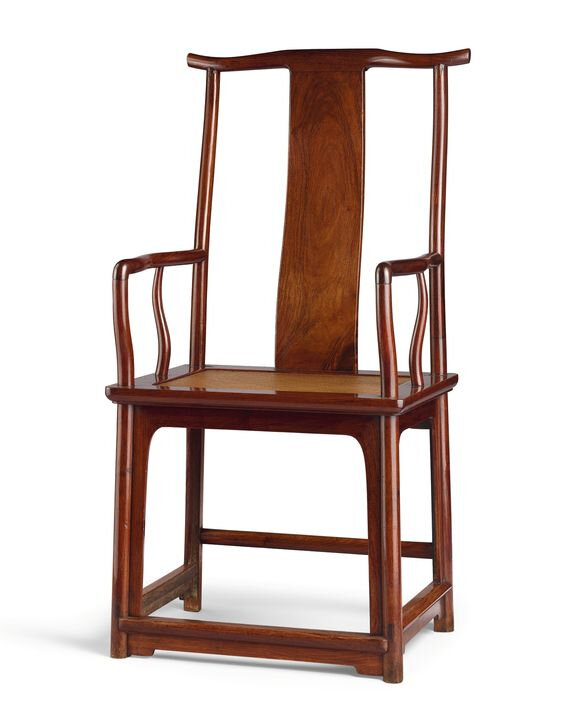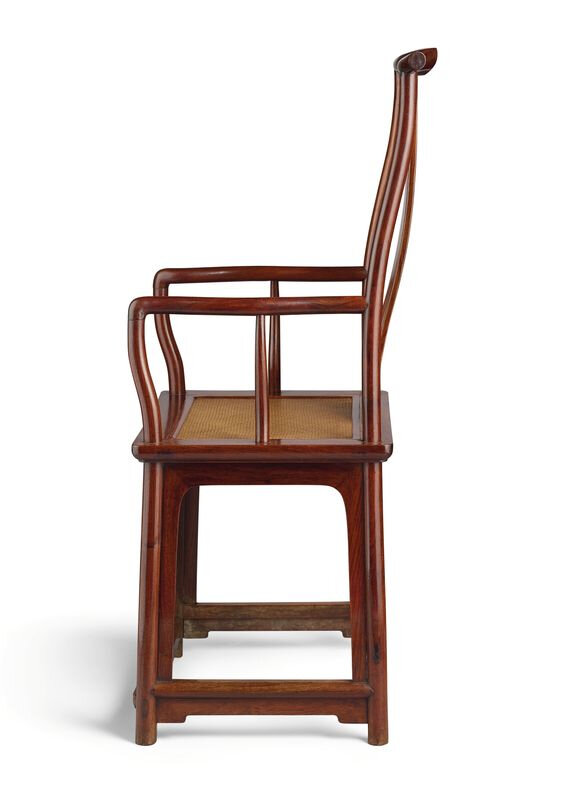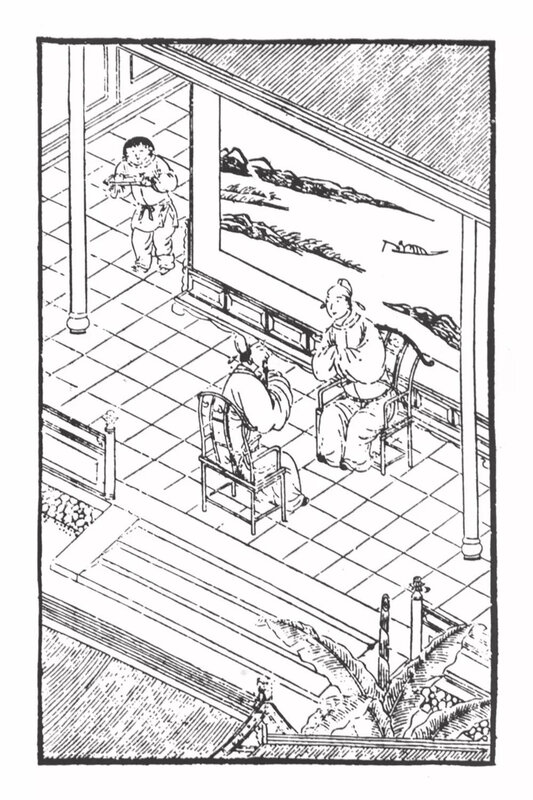Sotheby's. Important Chinese Art, Hong Kong, 03 oct. 2018, 03:00 PM
A pair of huanghuali high yokeback armchairs, Late Ming dynasty, late 16th – early 17th century
Lot 3622. A pair of huanghuali high yokeback armchairs, Late Ming dynasty, late 16th – early 17th century; 121.3 by 60.4 by 45.3 cm, 47 3/4 by 23 3/4 by 17 7/8 in. Estimate 10,000,000 — 15,000,000 HKD (1,273,900 - 1,910,850 USD). Unsold. Courtesy Sotheby's.
each with the shaped top rail with a small head-rest and gently everted ends, the plain S-shaped back splat tongue-and-grooved into the underside of the top rail and tenoned to the back member of the seat frame, the two black splats with active patterns cut from the same piece of wood, the stiles tenoned into the top rail and, like the front posts, pass through the seat forming the legs, the elongated S-shaped arms, mortised and tenoned into the stiles and pipe-joined to the posts, supported by tapering S-shaped braces of circular section, the mitred, mortised and tenoned seat frame with exposed tenons on the short rails and with two transverse braces underneath, the edge of the seat frame moulds downward and inward to end in a narrow flat band, drilled for soft seat construction fitted with old matting, all above a plain straight apron butt-joined to the underside of the seat, tongue-and-grooved into the legs and tenoned to the footrail, the side aprons similarly constructed whilst the back apron left plain and high, the legs joined by a shaped footrail in front, with rectangular side stretchers and an oval one in the back, all with exposed tenons, the footrest and stretchers with plain shaped aprons below.
Provenance: Collection of Mr and Mrs Robert P. Piccus.
Christie's New York, 18th September 1997, lot 40 (one of the pair).
Grace Wu Bruce, Hong Kong
Sarah Handler, A Yokeback Chair for Sitting Tall, Journal of the Classical Chinese Furniture Society, Spring 1993, no. 16.
Grace Wu Bruce, Chinese Furniture. Wenfang Works of Art, Hong Kong, 2003, cat. no. 3.
Note: Huanghuali yokeback armchairs of this type embody a timelessness in their striking linearity and harmony of form, and were associated with status and authority of the elite gentry in Chinese society. Known as guanmaoyi, or ‘official hat-shaped chairs’, due to their resemblance to the winged hat of Ming officials, they were further categorised into two types: those with protruding crest rails, sichutou guanmaoyi, and those without, nan guanmaoyi. The elegance of these chairs lies in the vertical lines which extend outwards slightly as they rise from the seat to lighten the overall effect.
The present pair of chairs combines an extending top rail with continuous arms, of which surviving examples are relatively rare; a closely related chair, attributed to the 17th century, is illustrated in Karen Mazurkewich, Chinese Furniture. A Guide to Collecting Antiques, Rutland, 2006, pl. 84; and a pair, but with shorter backs and attributed to the 17th/18th century, from the Robert H. Ellsworth collection, was sold at Christie’s New York, 18th March 2015, lot 106. The type is captured as a design of the Ming period, as depicted in wood block prints of the period; see an illustration to the drama written by Xu Fuzuo, Story of the Red Pear, illustrated in the catalogue to the exhibition Chinese Furniture. Wenfang Works of Art, Grace Wu Bruce, The International Asian Art Fair, New York, 2003, cat. no. 3 (fig. 1).
The remarkable level of carpentry is evident in the skilful construction of these chairs: the two plain S-shape back splats are carved from the same piece of wood and tongue-and-grooved into the underside of the top rail and tenoned to the back member of the seat frame. The stiles are tenoned into the top rail and pass through the seat to become the back legs, while the elongated S-shape arms form the front legs. These arms are mortised and tenoned into the stile and pipe-joined to the posts, supported by tapering S-shaped braces of circular section. Mitred, mortised and tenoned, the seat frame has exposed tenons on the short rails and two transverse braces underneath, while its edge moulds down and in to end in a narrow flat bend. Below the seat is a plain straight apron butt-joined to the underside of the seat. The legs are joined by a shaped footrail in front, rectangular side stretchers, and an oval one in the back, all with exposed tenons.
Craig Clunas in Chinese Furniture, London, 1988, p. 20, describes yokeback armchairs as being made in pairs, suggesting Chinese room arrangements aimed for symmetry. He further notes that Ming and Qing period literature illustrations characteristically show them used at dinner tables, in reception halls for guests and at the writing table in the scholar’s studio, and illustrates a woodblock print of the 1616 edition of The Golden Lotus (Jing Ping Mei), p. 22, fig. 8. This scene shows the main male figure and his principal wife seated on guanmaoyi while dining with his secondary wives and concubines who are seated on stools. For a general discussion on the basic model and decorative vocabulary of these armchairs see Curtis Evarts, ‘From Ornate to Unadorned’, Journal of the Chinese Classical Furniture Society, Spring 1993, pp. 24-33.
Huanghuali armchairs of this type, but with arms that extend over the posts, can be found in a number of museum and private collections; a closely related example, but with a wood seat, from the collection of Chen Mengjia, is illustrated in Wang Shixiang, Classic Chinese Furniture, Hong Kong, 1986, pl. 45; and another is included in George N. Kates, Chinese Household Furniture, New York, 1948, pl. 79.

/https%3A%2F%2Fprofilepics.canalblog.com%2Fprofilepics%2F1%2F0%2F100183.jpg)
/https%3A%2F%2Fstorage.canalblog.com%2F03%2F02%2F119589%2F96711876_o.jpg)
/https%3A%2F%2Fstorage.canalblog.com%2F11%2F31%2F119589%2F94773502_o.jpg)
/https%3A%2F%2Fstorage.canalblog.com%2F20%2F83%2F119589%2F94772815_o.jpg)
/https%3A%2F%2Fstorage.canalblog.com%2F26%2F72%2F119589%2F75604929_o.jpg)
/https%3A%2F%2Fstorage.canalblog.com%2F59%2F60%2F119589%2F26458628_o.jpg)








/image%2F1371349%2F20240409%2Fob_fc01a6_2024-nyr-22642-0899-000-a-rare-small-h.jpg)
/image%2F1371349%2F20240409%2Fob_1299ed_2024-nyr-22642-0898-000-a-rare-huanghu.jpg)
/image%2F1371349%2F20240403%2Fob_b08891_telechargement-4.jpg)
/image%2F1371349%2F20240403%2Fob_b24488_telechargement.jpg)